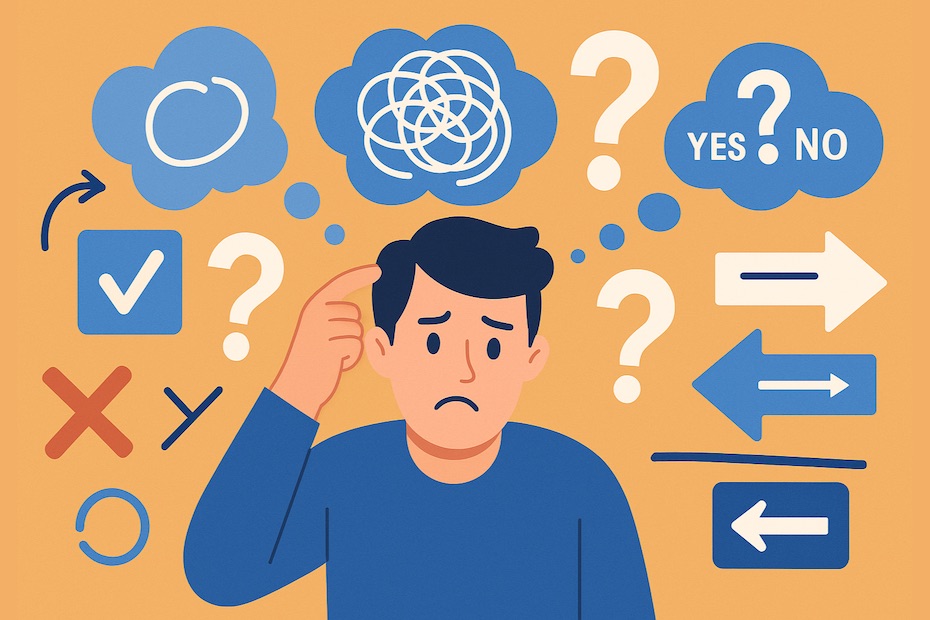You Think You’re a Rational Genius?
Of course you do. You read labels before buying shampoo. You once said “pass” on a timeshare. You even watched a documentary on Netflix called The Brain Explained, so clearly you’re running a tight cognitive ship.
Except… your brain is probably lying to you. Constantly. Like a sneaky little gremlin in your head whispering, “Buy the name brand. It’s better. Trust me.” This article is your wake-up call, your decoder ring, your Scooby-Doo unmasking scene for the mysterious monster known as cognitive bias.
Ready to discover why you think you’re in charge—when your subconscious is actually running the show like a caffeinated toddler with a steering wheel? Let’s go.
Meet the Villains – Cognitive Biases Assemble
You’re just out here living your life—ordering coffee, picking health insurance, choosing which socks to wear—and meanwhile your brain is like, “Hey, let’s base this major life decision on what Karen said in 2008.”
Say hello to your mental puppet masters:
- Confirmation Bias: You believe what you want to believe. Shocking.
- Anchoring Bias: First number you hear? That’s the one that sticks. Forever.
- Framing Effect: You’ll choose a 90% success rate over a 10% failure rate, even though… math.
- Availability Heuristic: Whatever you saw last on YouTube is now “obviously the truth.”
Your brain collects these like Pokémon cards, except instead of battling others, it just battles common sense.
The Framing Effect – Manipulation, But Make It Subtle
You’re choosing between two chicken wraps. One is “90% fat-free.” The other is “contains 10% fat.” You pick the first one, obviously. Because it sounds healthier. Because you’re a victim of framing bias.
Marketers love you. Politicians adore you. Your brain? It’s out here slurping up whatever sounds less scary.
It’s the same reason you buy “clean diesel” or think “lightly sweetened” somehow means zero sugar. It doesn’t. You know it doesn’t. And yet, here we are.
Anchoring – The First Price You Hear Is Gospel
You’re negotiating your salary. They say, “We’re thinking $45,000.” Your brain latches on like it’s a lifeline. Now $45K feels like a benchmark, even though your rent alone eats half of that. Anchoring bias has entered the chat.
Here’s the twist: You could know it’s happening and still fall for it. Anchoring is the friend who says, “I’m just looking” at Target and walks out $400 poorer. You didn’t plan on it, but the damage is done.
Oh, and retail stores? They love anchoring. That $800 coat you’d never buy? Just there to make the $399 coat look “reasonable.” Thanks, brain.
Confirmation Bias – You Versus Everyone Who Disagrees With You
You read one article that says eating chocolate cures anxiety. You send it to all your friends. You ignore the other 67 articles that say, “That’s not science.” Welcome to confirmation bias—your brain’s version of an echo chamber with mood lighting.
Why challenge your beliefs when you can just find someone with a blog who agrees with you?
Social media? Built on it. Political arguments with your uncle? Fueled by it. Your ability to “do your own research” and still be wildly wrong? Powered entirely by this delightful glitch in your neural matrix.
Availability Heuristic – If You Saw It, It Must Be True
You heard about one shark attack in Florida, and now you refuse to swim. You watched one documentary on pyramid schemes, and now you think your friend’s leggings business is a cult.
Your brain is lazy. It loves vivid, recent, and trauma-inducing. Facts? Pfft. Boring. You don’t remember the 12,000 people who didn’t get eaten by sharks—just that one lady on the news whose vacation ended in a Jaws sequel.
So yes, you’re afraid of flying but casually text while driving. Because statistics don’t matter—headlines do.
Sunk Cost Fallacy – “But I’ve Already Come This Far…”
You’re five seasons into a terrible TV show. It’s trash. You know it. But you’ve invested 70 hours of your life, so you have to finish. Enter: Sunk cost fallacy.
Same logic applies to staying in bad relationships, eating gross food you paid for, or continuing a career you hate just because “you already got the degree.”
Spoiler: That time is gone. It’s not coming back. But your brain will scream, “DON’T WASTE IT!” as it drags you through another season of Riverdale.
Bias Blind Spot – “I’m Totally Objective” You Say, Objectively
Here’s the kicker. The bias blind spot is your brain’s final troll move. It’s when you know biases exist, but you think they only apply to other people. Like those “sheeple.” Not you. You read articles. You’re enlightened.
Except you still picked a restaurant based on the font of the Yelp menu.
Sorry. You’re just as broken as the rest of us.
Top Sneaky Biases That Hijack Your Decisions
- Confirmation Bias – You only believe what agrees with you
- Anchoring Bias – The first number sticks forever
- Framing Effect – Same info, different spin = different choices
- Availability Heuristic – Recency rules your logic
- Sunk Cost Fallacy – “I’ve come this far” = classic trap
- Bias Blind Spot – You think you’re not biased (you are)
- Overconfidence Bias – You’re not as rational as you think
Conclusion: You’re Not in Control—But You Can Buckle Up
So no, you’re not the ultra-rational, logic-powered mastermind you thought you were. You’re a fleshy little algorithm full of shortcuts, snap judgments, and biases dressed up as gut feelings.
But now that you know, you’re at least a self-aware walking paradox. That’s the first step to not accidentally joining a cult or overbidding on eBay at 2 a.m.
Final advice? Next time your brain whispers “this seems right,” give it the side-eye and say, “Nice try, meat computer.”
Then double-check your sources, take a breath, and maybe—just maybe—don’t buy that $400 smoothie blender.
Cassandra Toroian is also a content creator on Linkdin. Join her professional community to get more advice and connect with professionals from your industry.

Cassandra Toroian is a sports-tech entrepreneur and CEO/co-founder of Ruley, the AI “e-referee” serving tennis, pickleball, padel, golf, and soccer. With 25+ years building companies—and a background in finance (MBA) plus Python training—she’s also co-founder of Volleybird and author of Don’t Buy the Bull. A former Division I tennis player, she’s focused on using AI to make sport fairer and more accessible.

